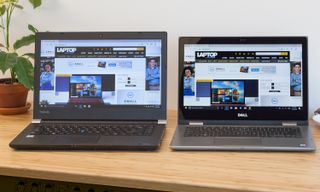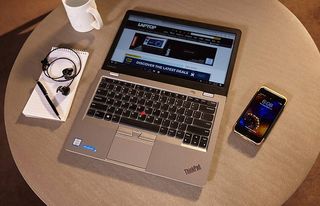Most Business Laptops Still Have Horrible, Low-Res Screens. Here's Why.
In 2018, you wouldn't expect to start a new job, be shown to your desk and find an electric typewriter sitting there instead of a computer. You'd be shocked if the IT staff handed you a gray-scale BlackBerry 6230 and said, "This is your corporate-issued smartphone; carry it at all times." And even if your company's CIO was foolish enough to want to buy electric typewriters and 15-year-old handsets for employees, he or she wouldn't find a company that still manufactures and sells such outdated technology.

Unfortunately, in 2018, laptop makers are more than happy to make business laptops with old-fashioned, productivity-draining 1366 x 768 screens, and there are corporate customers foolish enough to purchase them. According to analyst firm NPD, in 2017, 51.7 percent of laptops that businesses purchased had screen resolutions of less than 1920 x 1080 — most commonly, 1366 x 768, the lowest number of pixels you can get on a modern laptop.
"Everyone has to make choices around specs, and screen resolution tends to be one of the areas that businesses are comfortable trading down on." — Stephen Baker, analyst, NPD
The difference between having a 1920 x 1080 (aka 1080p) screen and one with a 1366 x 768 resolution is the difference between being able to edit documents, read web pages or multitask without constant scrolling and window switching and not being able to do any of those things. Just try reading a web page or paging through a report with only 768 pixels of vertical real estate. After you take away space for menus, window bars and the taskbar, you barely have room to see a few paragraphs of text at once.
If you have 1080 pixels, that's 40 percent more text and graphics than 768. With 1920 horizontal pixels, you can stack two full-width windows side by side for multitasking, whereas if you have only 1366 of those, it makes it difficult to multitask. And what business user wants to edit a spreadsheet with only a few columns showing at once?
We've said for years that 1366 displays on laptops are a bad joke and that manufacturers should be ashamed to continue selling them. Still, if you look at the leading commercial notebook manufacturers — Dell, Lenovo and HP — all of them offer systems with 1366 displays, and some of those notebooks can't even be configured with 1080p screens.
Just as one can no longer buy a business laptop with a floppy-disk drive or a trackball, one should not be able to purchase a notebook with a 1366-resolution screen.
For example, Dell recently started shipping the 12-inch Latitude 7290, a premium business laptop with a starting price of $1,498 (currently on sale for $1,049) and configurations that cost as much as $2,070. There is no option to get this pricey laptop with anything but a 1366 display.
Our favorite business laptop of 2017, the Lenovo ThinkPad T470, comes with a 1366 x 768 display on the base model, but it costs just $70 to upgrade to 1920 x 1080. HP's ProBook 650 starts at $899 and defaults to a 1366 display, though it costs only $39 to upgrade to 1080p.
Stay in the know with Laptop Mag
Get our in-depth reviews, helpful tips, great deals, and the biggest news stories delivered to your inbox.
If it costs the customer only $39 to $70 to get a decent screen on a business laptop, it probably costs the manufacturer a fraction of that. Rather than nickel and dime their customers, the companies should make 1080p the lowest standard resolution on any business laptop and raise their base prices accordingly.
The flip side of the argument is that business customers sometimes want to save that $39, and if they're buying 10,000 laptops, the savings add up. Speaking off the record, representatives at a couple of manufacturers told me that they continue to offer these low-resolution displays because corporate clients still want them.
"Road warriors need full features, and we are gradually seeing everyone get a better screen," NPD analyst Stephen Baker told me. "But price is still very important in business as well, and not everybody can get a top-of-the-line product. Everyone has to make choices around specs, [and] that [screen resolution] tends to be one of the areas that businesses (and consumers) are comfortable trading down on."
It's understandable that consumers who are on tight budgets would want to pinch every single penny, but businesses that aren't willing to spend a few extra dollars to make their employees more productive are shooting themselves in the foot. And laptop vendors are helping them make their workers less efficient.
What business user wants to edit a spreadsheet with only a few columns showing at once?
Companies that don't buy their employees laptops with 1080p screens often cheap out on other features. In 2017, the average selling price of a business laptop with a 1080p screen was $1,275, but for low-res screens, that number dropped to just $571.

However, a low budget is no excuse. You can get a Dell Latitude 14 3000, the lowest-end Latitude, with a 1080p screen for just $550, or a ThinkPad 13 (pictured above), one of Lenovo's cheapest, for around $680. Granted, these notebooks have low-end processors and storage, but that's to be expected of any business laptop under $800.
Some people I talked to both inside and outside of the computer industry suggested that, for business users who connect to docking stations with large monitors at their desks, laptop screen quality doesn't matter. Of course, we have a name for a computer that sits on your desk all the time: "desktop." If screens don't matter, neither do keyboards or battery life or anything else.
Even if employees only carry their notebooks to meetings and on the train, they need to be able to get work done. And if they can't be productive on their business laptop because it has a terrible screen, that will affect their opinion of the brand when it comes time for them to buy their own computers.
Vendors need to understand that the customer isn't always right. If a Fortune 500 CTO asked you to manufacture a laptop that gives the user a painful shock after 15 minutes of inactivity, would you make one? Just as you can no longer buy a business laptop with a floppy-disk drive or a trackball, you should not be able to purchase a notebook with a 1366-resolution screen.
